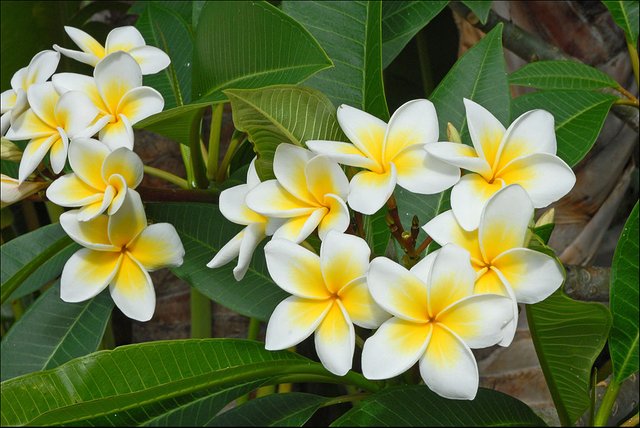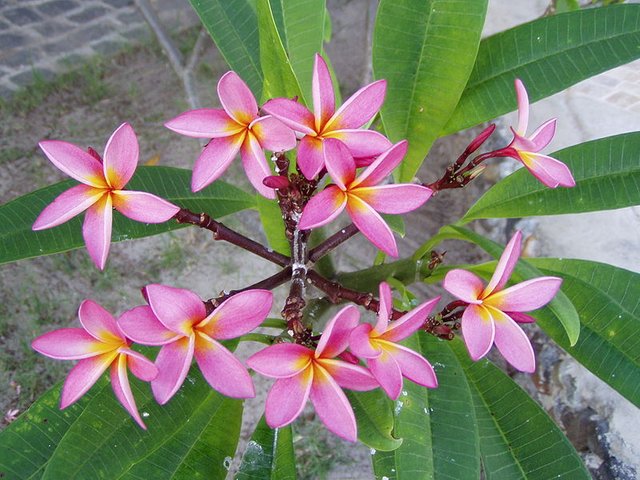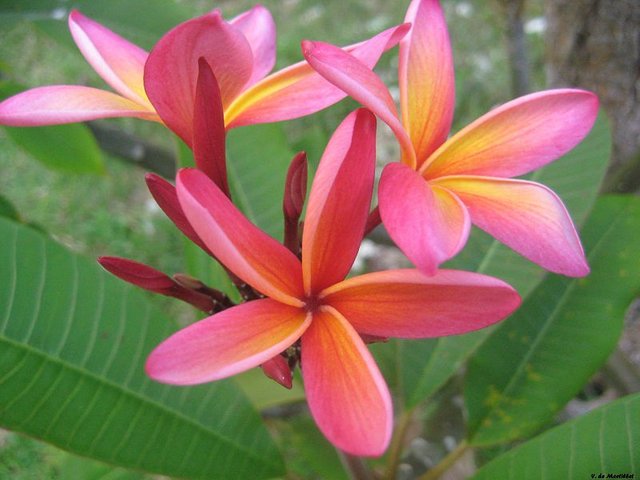Impatiens
Does the scent of the Frangipani or Hawaiian Lei Flower immediately transport you to a tropical resort complete with brilliant blue skies, waving palm fronds and crystal clear seas? It certainly does for me! Ever since my father brought me back a tiny bottle of Plumeria perfume from Hawaii when I was a little girl: the scent has always been redolent of all things tropical and puts me in a holiday frame of mind.
The Frangipani or Plumeria rubra var. acutifolia (syn. P. acuminata) is native to tropical America but is now grown all around the world in both tropical and temperate climates. Many people think it is native to Hawaii so widely associated it has become with the beautiful floral leis with which each visitor to these islands is greeted. Plumeria is named after the French botanist Charles Plumier (1646-1704) and its common name is from the 16th century Italian perfumer the Marquis Frangipani, whose scent for gloves was said to be similar to the scent of the Plumeria.
Frangipanis are very easy to strike from cuttings and in this way many forms have been passed on from friend to friend and from generation to generation. A section of branch tip usually about 30cm in length is removed in late winter (cut at a 45 degree angle) and allowed to callous over in a warm dry spot for about two weeks. This is then inserted about 8cms into a free draining mix in a pot. Rooting hormone may help but is not essential. The drying out process is important to allow the cut to callus over and then the base of the cutting will not rot when it is put in the potting mix. The cutting should start to produce leaves in 4-6 weeks and then you can start watering it regularly. An open sunny position with good drainage and reasonably fertile soil is the ideal place to grow a frangipani. This tree is often evergreen in the tropics but deciduous in more temperate areas and grows to about 4m in height. In winter its naked branches look a little like staghorn coral or as my daughter said – the antlers on a reindeer – a whole herd of reindeer!
Frangipanis flower from summer to autumn in a range of breathtaking colours. The basic white five petalled flower with its central yellow stain has been eclipsed in many ways by a range of sunset colours including orange, pink, red, gold, apricot, salmon, shrimp and watermelon to name just a few! The Americans seem to have names for all these various colour types but in Australia they are mostly sold just by colour. Leo Schofield in his book The Garden at Bronte (Viking 2002) writes about his obsession with the frangipani and his efforts to collect all the different forms he finds. His plants are ‘named’ according to the location of the parent plant.
One American plumeria fancier rates cultivars (among other things) according to flower type and texture. Flower type refers to flowers that open fully like a salver or propeller to half open – referred to as a semi-shell and those that hardly open at all – referred to as a shell as they look like small spiral seashells. Flower texture is rated from fragile to delicate to strong and finally rigid. Apparently rigid flowers are good for making into leis!
On some American websites there are pictures of the most extraordinary new flowers like ‘Sariah’s Curly Pink’ and ‘Ammaron’s Curly White’. Many American Plumeria fanciers grow their plants in huge tubs which are wheeled outside for the summer and back inside over the winter when they become dormant. We can do this too in Australia especially in areas south of Sydney which is seen as being too cold to grow frangipanis outdoors. I have seen this myth dispelled but you do need to take the following into account.
The tree must be in
- A north facing position
- A brick/concrete wall behind it would be good (this reflects heat back to the plant at night)
- Light coloured gravel mulch is good
- Excellent drainage
- No frosts



Congratulations! This post has been upvoted from the communal account, @minnowsupport, by hnub from the Minnow Support Project. It's a witness project run by aggroed, ausbitbank, teamsteem, someguy123, neoxian, followbtcnews, and netuoso. The goal is to help Steemit grow by supporting Minnows. Please find us at the Peace, Abundance, and Liberty Network (PALnet) Discord Channel. It's a completely public and open space to all members of the Steemit community who voluntarily choose to be there.
If you would like to delegate to the Minnow Support Project you can do so by clicking on the following links: 50SP, 100SP, 250SP, 500SP, 1000SP, 5000SP.
Be sure to leave at least 50SP undelegated on your account.
You got a 0.77% upvote from @minnowvotes courtesy of @hnub!